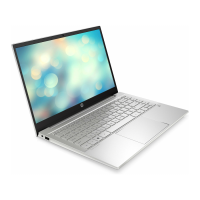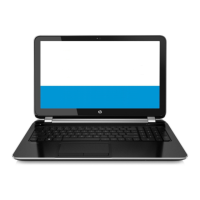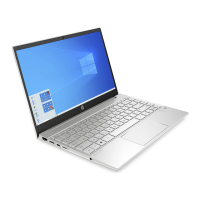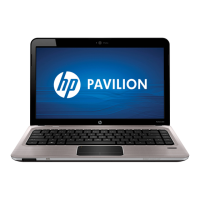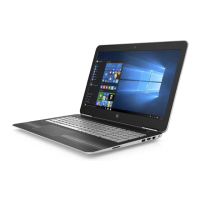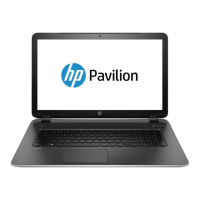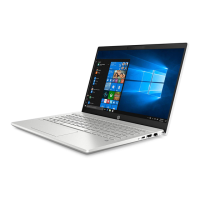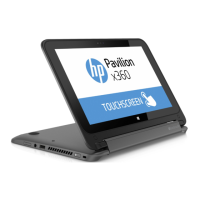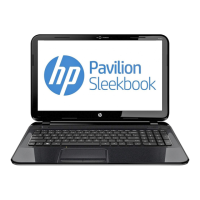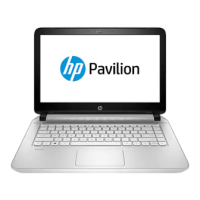Do you have a question about the HP Pavilion 17 and is the answer not in the manual?
| Bus type | DMI |
|---|---|
| Stepping | L1 |
| Tjunction | 90 °C |
| Processor cache | 3 MB |
| Processor cores | 2 |
| Processor model | i3-3110M |
| System bus rate | 5 GT/s |
| Processor family | Intel® Core™ i3 |
| Processor series | Intel Core i3-3100 Mobile Series |
| Processor socket | BGA 1023 |
| Processor threads | 4 |
| Processor codename | Ivy Bridge |
| Processor frequency | 2.4 GHz |
| Processor cache type | Smart Cache |
| Processor lithography | 22 nm |
| Processor manufacturer | Intel |
| Processor front side bus | - MHz |
| PCI Express slots version | 2.0 |
| Processor operating modes | 64-bit |
| ECC supported by processor | No |
| PCI Express configurations | 1x16, 2x8, 1x8+2x4 |
| Thermal Design Power (TDP) | 35 W |
| CPU multiplier (bus/core ratio) | 24 |
| Maximum number of PCI Express lanes | 16 |
| Motherboard chipset | Intel HM76 Express |
| Memory slots | 2x SO-DIMM |
| Internal memory | 6 GB |
| Memory clock speed | 1600 MHz |
| Memory form factor | SO-DIMM |
| Internal memory type | DDR3-SDRAM |
| Maximum internal memory | - GB |
| Memory layout (slots x size) | 1 x 2 + 1 x 4 GB |
| HDD size | 2.5 \ |
| HDD speed | 5400 RPM |
| HDD interface | SATA |
| Storage media | HDD |
| Optical drive type | DVD Super Multi DL |
| Card reader integrated | Yes |
| Total storage capacity | 500 GB |
| Compatible memory cards | MMC, SD |
| Number of HDDs installed | 1 |
| Number of SSDs installed | 0 |
| Display surface | Gloss |
| Display diagonal | 17.3 \ |
| Display resolution | 1600 x 900 pixels |
| Native aspect ratio | 16:9 |
| Display number of colors | 16.78 million colors |
| Disc types supported | CD, DVD |
| On-board graphics card ID | 0x166 |
| Discrete graphics card model | Not available |
| On-board graphics card model | Intel® HD Graphics 4000 |
| On-board graphics card family | Intel® HD Graphics |
| On-board graphics card memory | 1.65 GB |
| On-board graphics card base frequency | 650 MHz |
| On-board graphics card dynamic frequency (max) | 1000 MHz |
| Audio system | DTS Sound+ |
| Front camera resolution | 1280 x 720 pixels |
| WWAN | Not installed |
| Data network | Not supported |
| Wi-Fi standards | 802.11b, 802.11g, Wi-Fi 4 (802.11n) |
| Cabling technology | 10/100Base-T(X) |
| Top Wi-Fi standard | Wi-Fi 4 (802.11n) |
| Ethernet LAN data rates | 10, 100 Mbit/s |
| Charging port type | DC-in jack |
| Headphone connectivity | 3.5 mm |
| USB 2.0 ports quantity | USB 2.0 ports have a data transmission speed of 480 Mbps, and are backwards compatible with USB 1.1 ports. You can connect all kinds of peripheral devices to them. |
| Keyboard layout | - |
| Pointing device | Touchpad |
| Operating system installed | Windows 8 |
| Form factor | Clamshell |
| Product type | Laptop |
| Product color | Black, Silver |
| Country of origin | China |
| Processor code | SR0N2 |
| Processor ARK ID | 65700 |
| Processor package size | 37.5 x 37.5 (rPGA988B); 31 x 24 (BGA1023) mm |
| Supported instruction sets | AVX |
| Intel Identity Protection Technology version | 1.00 |
| Battery life (max) | - h |
| Number of battery cells | 6 |
| AC adapter power | 65 W |
| AC adapter frequency | 50 - 60 Hz |
| AC adapter input voltage | 100 - 240 V |
| AC adapter output current | 3.42 A |
| AC adapter output voltage | 19 V |
| Cables included | AC |
| Operating altitude | 0 - 3050 m |
| Non-operating altitude | 0 - 4570 m |
| Storage temperature (T-T) | -15 - 60 °C |
| Operating temperature (T-T) | 5 - 35 °C |
| Storage relative humidity (H-H) | 10 - 90 % |
| Operating relative humidity (H-H) | 20 - 85 % |
| Sustainability certificates | RoHS, EPEAT Silver, ENERGY STAR |
| Depth | 267 mm |
|---|---|
| Width | 420 mm |
| Height | 32.8 mm |
| Weight | 2900 g |
Details about AMD and Intel processors used in HP Pavilion Notebook PCs.
Information on integrated and switchable graphics options for the notebook.
Details on memory configurations and SODIMM slots.
Information on supported hard drive sizes, types, and thicknesses.
Lists available ports like AC Smart Pin, RJ-45, USB, and HDMI.
Details on the keyboard, TouchPad, and gesture support.
Steps to find hardware information using Device Manager and fn+esc.
Identification and description of components on the right side of the computer.
Identification and description of components on the left side of the computer.
Identification and description of display components like webcam and antennas.
Identification and description of top components like the TouchPad and keys.
Identification and description of bottom components like battery bay and vents.
Lists major components of the computer with spare part numbers for identification.
Lists spare parts for display assembly subcomponents like bezels and hinges.
Identification and spare parts for hard drives and optical drives.
Lists spare parts for miscellaneous items like AC adapters and power cords.
Lists the necessary tools for component removal and replacement procedures.
Important considerations for disassembly and assembly procedures.
Guidelines for handling and routing computer cables and connectors properly.
Precautions for handling fragile drive components to prevent damage.
Information and precautions related to electrostatic discharge (ESD).
General introduction to procedures for replacing customer-accessible computer parts.
Step-by-step instructions for removing and installing the computer battery.
Instructions for removing and installing the computer's optical drive.
Introduction to procedures for replacing parts accessible only by authorized service providers.
Procedures for removing and replacing the base enclosure of the computer.
Procedures for removing and replacing the computer's display panel assembly.
Procedures for removing and replacing the computer's system board.
Procedures for removing and replacing the computer's heat sink assembly.
Procedures for removing and replacing the computer's power button board.
Instructions on how to access and start the computer's BIOS Setup Utility.
Information and steps for updating the computer's BIOS.
Detailed instructions on how to download a BIOS update from the HP website.
How to use the HP PC Hardware Diagnostics tool for system testing.
Instructions to start the Setup Utility in Ubuntu Linux.
General information and navigation within the Ubuntu Linux Setup Utility.
Steps to restore factory default settings in the Ubuntu Linux Setup Utility.
General technical specifications for HP Pavilion Notebook PCs.
Detailed technical specifications for the 17.3-inch display.
Detailed technical specifications for the 15.6-inch display.
Technical specifications for various hard drive models.
Information on creating recovery media and system backups in Windows 8.1.
Step-by-step guide for creating HP Recovery media using HP Recovery Manager.
Options for recovering the system and restoring data in Windows.
Steps and recommendations for creating system and personal data backups.
Guide to creating recovery media for system restoration.
Information on system restore points and how to create them.
Guide to performing system recovery in Ubuntu Linux using restore media.
Instructions for creating system restore DVDs in Ubuntu Linux.
Methods for backing up user data in Ubuntu Linux.
General requirements for power cord sets applicable to all regions.
Specific requirements for power cord sets based on country and region.
